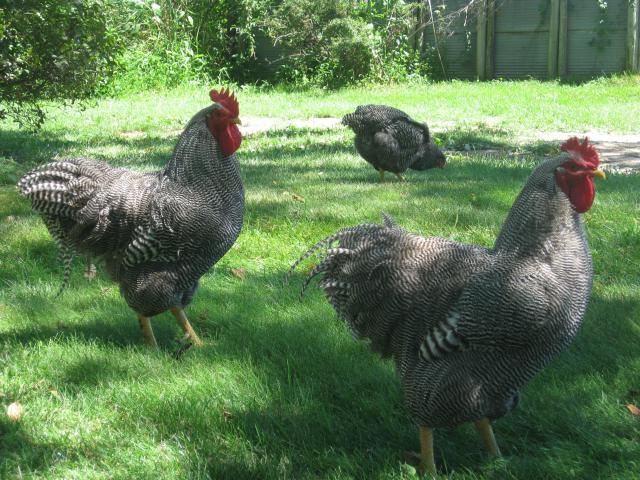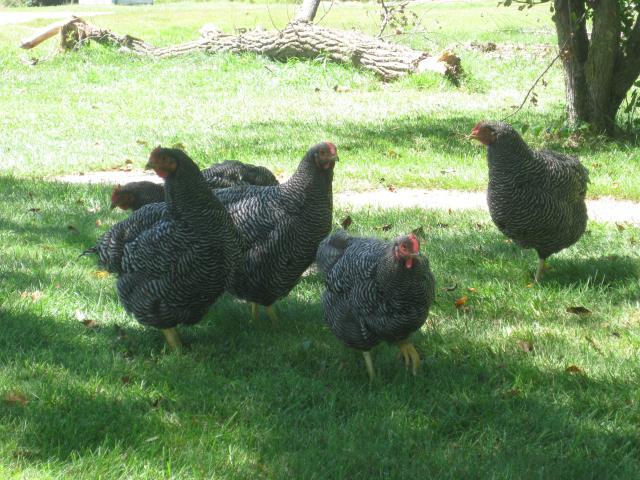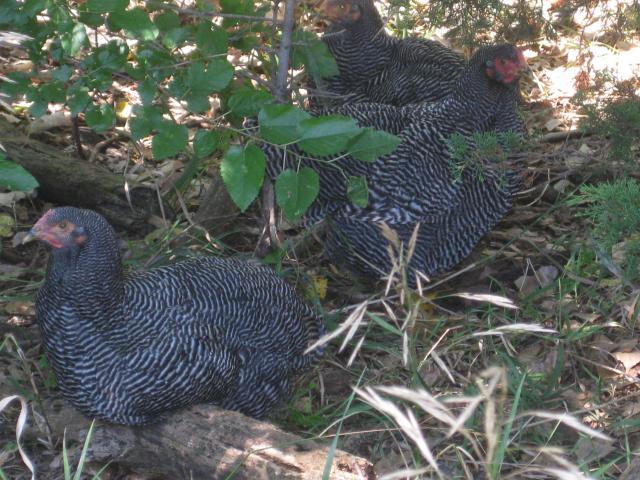Quote:
I feel the same as Matt Lhamon on this term and it is getting to be a new marketing term to get people to raise some of the old breeds. Here is the ALBC "Definition of a Heritage Chicken" -
Definition:
Heritage Chicken must adhere to all the following:
1. APA Standard Breed. Heritage Chicken must be from parent and grandparent stock of breeds recognized by the American Poultry Association (APA) prior to the mid-20th century; whose genetic line can be traced back multiple generations; and with traits that meet the APA Standard of Perfection guidelines for the breed. Heritage Chicken must be produced and sired by an APA Standard breed. Heritage eggs must be laid by an APA Standard breed.
2. Naturally mating. Heritage Chicken must be reproduced and genetically maintained through natural mating. Chickens marketed as Heritage must be the result of naturally mating pairs of both grandparent and parent stock.
3. Long, productive outdoor lifespan. Heritage Chicken must have the genetic ability to live a long, vigorous life and thrive in the rigors of pasture-based, outdoor production systems. Breeding hens should be productive for 5-7 years and roosters for 3-5 years.
4. Slow growth rate. Heritage Chicken must have a moderate to slow rate of growth, reaching appropriate market weight for the breed in no less than 16 weeks. This gives the chicken time to develop strong skeletal structure and healthy organs prior to building muscle mass.
Chickens marketed as Heritage must include the variety and breed name on the label.
Terms like heirloom, antique, old-fashioned, and old timey imply Heritage and are understood to be synonymous with the definition provided here.
Abbreviated Definition: A Heritage Egg can only be produced by an American Poultry Association Standard breed. A Heritage Chicken is hatched from a heritage egg sired by an American Poultry Association Standard breed established prior to the mid-20th century, is slow growing, naturally mated with a long productive outdoor life.
The American Livestock Breeds Conservancy has over 30 years of experience, knowledge, and understanding of endangered breeds, genetic conservation, and breeder networks.
Endorsed by the following individuals:
Frank Reese, Reese Turkeys, Good Shepherd Turkey Ranch, Standard Bred Poultry Institute, and American Poultry Association;
Marjorie Bender, Research & Technical Program Director, American Livestock Breeds Conservancy
D. Phillip Sponenberg, DVM, PhD., Technical Advisor, American Livestock Breeds Conservancy, and Professor, Veterinary Pathology and Genetics, Virginia Tech;
Don Bixby, DVM. Independent Consultant, former Executive Director for the American Livestock Breeds Conservancy;
R. Scott Beyer, PhD, Associate Professor, Poultry Nutrition Management, Kansas State University,
Danny Williamson, Windmill Farm, Good Shepherd Turkey Ranch, and American Poultry Association;
Anne Fanatico, PhD, Research Associate, Center for Excellence for Poultry Science, University of Arkansas;
Kenneth E. Anderson, Professor, Poultry Extension Specialist, North Carolina State University.
Chris
Now, for a thread or site on that very criteria. . .

Seriously, forget hatchery bred stuff - Where's the real, heritage, APA fit breeds?
I believe/ hope that this thread could be that thread.
A very knowledgeable breeder has started this thread and should have a lot to offer.
I think that a lot of "breeders" /people just assume that just because they have a Barred Rock or a Rhode Island Red that they have a " Heritage " breed chicken but seem to forget that a Heritage breed is bred to the American Standard of Perfection...
But I do hope that we can get some of the more serious breeders of "Heritage" Breeds that are bred to the Standard in here.
Chris
I feel the same as Matt Lhamon on this term and it is getting to be a new marketing term to get people to raise some of the old breeds. Here is the ALBC "Definition of a Heritage Chicken" -
Definition:
Heritage Chicken must adhere to all the following:
1. APA Standard Breed. Heritage Chicken must be from parent and grandparent stock of breeds recognized by the American Poultry Association (APA) prior to the mid-20th century; whose genetic line can be traced back multiple generations; and with traits that meet the APA Standard of Perfection guidelines for the breed. Heritage Chicken must be produced and sired by an APA Standard breed. Heritage eggs must be laid by an APA Standard breed.
2. Naturally mating. Heritage Chicken must be reproduced and genetically maintained through natural mating. Chickens marketed as Heritage must be the result of naturally mating pairs of both grandparent and parent stock.
3. Long, productive outdoor lifespan. Heritage Chicken must have the genetic ability to live a long, vigorous life and thrive in the rigors of pasture-based, outdoor production systems. Breeding hens should be productive for 5-7 years and roosters for 3-5 years.
4. Slow growth rate. Heritage Chicken must have a moderate to slow rate of growth, reaching appropriate market weight for the breed in no less than 16 weeks. This gives the chicken time to develop strong skeletal structure and healthy organs prior to building muscle mass.
Chickens marketed as Heritage must include the variety and breed name on the label.
Terms like heirloom, antique, old-fashioned, and old timey imply Heritage and are understood to be synonymous with the definition provided here.
Abbreviated Definition: A Heritage Egg can only be produced by an American Poultry Association Standard breed. A Heritage Chicken is hatched from a heritage egg sired by an American Poultry Association Standard breed established prior to the mid-20th century, is slow growing, naturally mated with a long productive outdoor life.
The American Livestock Breeds Conservancy has over 30 years of experience, knowledge, and understanding of endangered breeds, genetic conservation, and breeder networks.
Endorsed by the following individuals:
Frank Reese, Reese Turkeys, Good Shepherd Turkey Ranch, Standard Bred Poultry Institute, and American Poultry Association;
Marjorie Bender, Research & Technical Program Director, American Livestock Breeds Conservancy
D. Phillip Sponenberg, DVM, PhD., Technical Advisor, American Livestock Breeds Conservancy, and Professor, Veterinary Pathology and Genetics, Virginia Tech;
Don Bixby, DVM. Independent Consultant, former Executive Director for the American Livestock Breeds Conservancy;
R. Scott Beyer, PhD, Associate Professor, Poultry Nutrition Management, Kansas State University,
Danny Williamson, Windmill Farm, Good Shepherd Turkey Ranch, and American Poultry Association;
Anne Fanatico, PhD, Research Associate, Center for Excellence for Poultry Science, University of Arkansas;
Kenneth E. Anderson, Professor, Poultry Extension Specialist, North Carolina State University.
Chris
Now, for a thread or site on that very criteria. . .

Seriously, forget hatchery bred stuff - Where's the real, heritage, APA fit breeds?
I believe/ hope that this thread could be that thread.
A very knowledgeable breeder has started this thread and should have a lot to offer.
I think that a lot of "breeders" /people just assume that just because they have a Barred Rock or a Rhode Island Red that they have a " Heritage " breed chicken but seem to forget that a Heritage breed is bred to the American Standard of Perfection...
But I do hope that we can get some of the more serious breeders of "Heritage" Breeds that are bred to the Standard in here.
Chris















